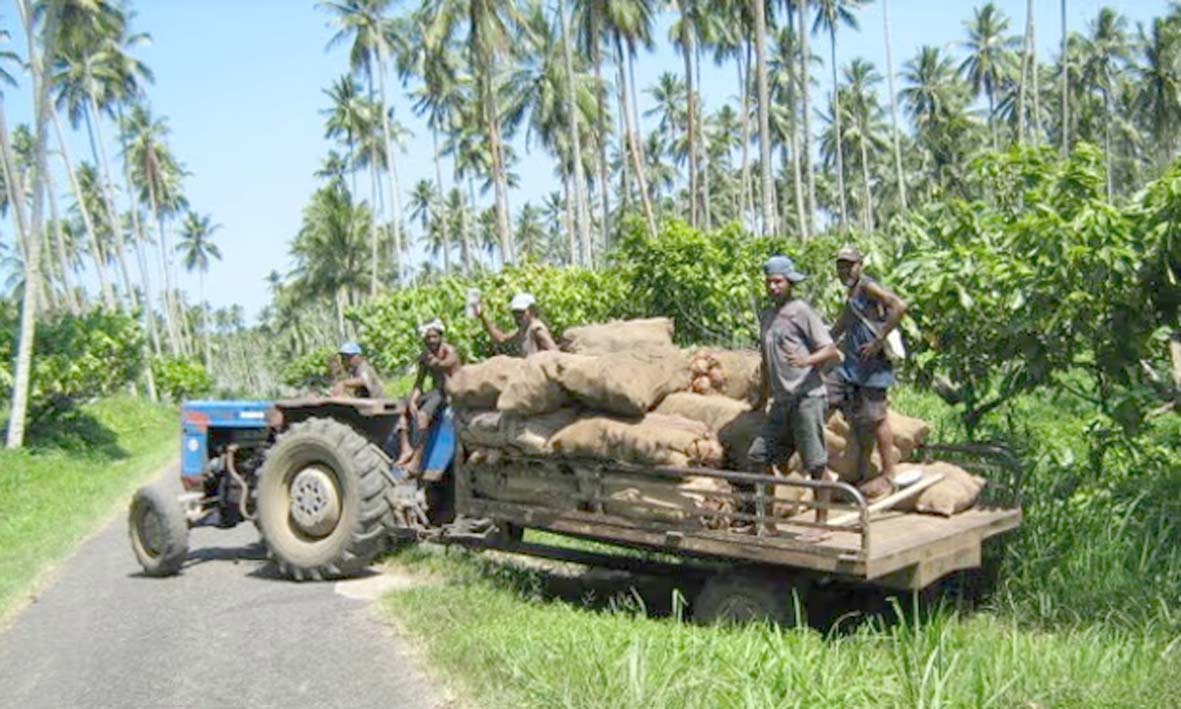Producing Copra on New Ireland
Ian Smith
This story follows an earlier article of Ian’s, published in 2022, about Patlangat Plantation in New Ireland.
 Working with Papua New Guinea Highlanders on a remote coastal copra plantation in the early 1960s could be a real challenge, especially for a young trainee manager like me.
Working with Papua New Guinea Highlanders on a remote coastal copra plantation in the early 1960s could be a real challenge, especially for a young trainee manager like me.
WR Carpenter (PNG), the company I worked for, owned 30 large copra and cocoa plantations and as a new cadet trainee manager in the 1960s I had to quickly learn all aspects of what the company required of me.
This entailed keeping business records, signed employee labour contracts, ordering and storing tons of food supplies that had to be accounted for, and tractor and machinery maintenance. Ordering supplies took particular skill and experience to competently anticipate the plantation’s requirements, given the long lead times, particularly from Australia, and the uncertainties of the weather. All freight to and from the plantation was by sea.
In keeping with government regulations, we also had to pass a six-week Medical Assistants Course that was held at Nonga Base Hospital in Rabaul.
A copra plantation producing 30 to 40 tons per month of dried copra would normally require 180 to 200 workers, and producing this tonnage of dried copra requires approximately 60,000 palm trees. Generally, plantations had many trees that were planted in the German times, covering 1884 until 1914. The older trees would be extremely tall, making them more susceptible to lightning strikes and insect pests. Plantations needed to keep up a constant replanting program, requiring seedling nurseries to be established.
Coconut palms were evenly spaced in lines and planted in a square configuration for ease of management. Plantations near Rabaul and Madang and some on Bougainville grew cocoa between the palm trees. Cocoa, however, demands significant processing facilities and a lot more labour to cultivate, maintain, harvest and process. This made it impractical on isolated plantations such as the one I was on, on the East coast of New Ireland.
The plantation was usually worked by focusing on one particular area of the plantation at a time, usually determined by the length of the kunai grass and the number of fallen nuts apparent in the area. Large numbers of plantation workers were employed to work in teams to cut the kunai with a hand-held steel ‘sarif’, made from approximately 1.5 m lengths of re-purposed steel strapping that had held the bales of empty hessian sacks and sharpened by hammering the edge on an anvil. The grass cutters were usually the largest team and, for that reason, usually known as the big lain. Usually following the grass cutters were copra cutters, who gathered up the fallen coconuts into piles. Working around these piles, the cutting crew cut the nuts in half with an axe, removing the white kernel with a sharp knife before packing the wet copra into hessian bags.
Towards the end of the day, tractors pulling large trailers, each with six to eight men on board, collected the bags of cut copra and transported them to the drying shed. Later, the remaining coconut husks, which still contained the hard shell from which the copra had been cut, were taken to the drying shed to be used to fire brick furnaces for the hot air drying process. It was at the drying shed where every bag was weighed to determine whether the copra cutters had met their daily quota.
Inside the shed, wire mesh racks were set up for the wet copra. Drying copra was a 24-hour, seven-days-a-week process, requiring teams of firemen rostered in shifts. Once dried, the copra was taken to a storage shed, and rammed with a wooden pole into the bags. The storage shed on coastal plantations was usually near the beach for easier loading on ships.
Coastal ships might turn up every month, if not a few weeks later, bringing with them food supplies—tons of bagged rice and boxes of tinned fish and meat, machinery parts, household goods, whatever was ordered previously by radio. And, of course, many 44-gallon drums of fuel and lubricating oil.
With few plantations having a deepwater wharf, most coastal ships had to anchor off the reef, and unload and load cargo using a diesel engined pinnace, towing one or more lighters to and from the shore.
Incoming cargo was offloaded before the copra was loaded. Loading and unloading cargo were critical times as coral reefs and tropical storms were a constant source of risk for the plantation and the ship.
The 44-gallon drums were sometimes simply dropped over the side of the ship and floated ashore. Once the ship unloaded its cargo for that plantation, the heavy bags of dried copra, weighing as much as 60 kg, were taken on board. The bags were usually carried from the shed perched on the labourer’s shoulder to the waiting lighter at the water’s edge.
There was no such thing as a handbook on native labour or details about cultural or ethnic background, and yet these men were the backbone of the plantation’s workforce. As many plantation managers experienced, including myself, inter-tribal and inter-clan paybacks and disputes often occurred between groups. It was difficult at times to understand how and why personal grievances continued after the feuding factions or individuals had left their remote home villages. It always surprised me how quickly the men learned to speak Tok Pisin. We often ended up having very funny conversations, which included hand actions and facial expressions to bridge language gaps.
The Highland workers on plantations I was involved with represented four or five different tribes; Chimbu, Wabag, Minj, etc. As one group completed its two-year indentured contract, another group arrived on the next ship.
Some groups earned a reputation for being aggressive to other workers, so it was a balancing act for the manager to maintain peace and tolerance. In some situations, it was best to have wantoks work together. It encouraged a sense of competition between tribal groups and was good for copra production.
Each tribe appointed their own cooks who were supplied food from the plantation storerooms. Large cauldrons of rice were prepared to which was added fish or meat. Rations included cooked oaten fried cakes along with billy tea and so forth. Everyone had three square meals per day. It was a responsible job.
There were never any idle workers, and that included the plantation manager. Everyone pulled together to produce the expected monthly copra tonnage. This was not always easy to achieve, especially in times of constant rain, machinery breakdowns, and various other incidents that inevitably affected copra production. Lead times for major spare parts or repairs could run for more than a month.
Training a new tractor driver required patience, as in those days few Highlanders had any experience with vehicles or machinery, let alone maintaining them. Breakdowns related to tractor clutches and gearboxes were a major problem that the manager had to fix, usually under a lean-to shed with a dirt floor. These complicated repairs would normally be done in a fully equipped workshop by a trained mechanic but on an isolated plantation it was a case of consulting the tractor workshop and spare parts manuals. For readers unfamiliar with tractor clutches and gearboxes, it requires splitting the tractor into two halves. These types of breakdowns were annoying as it meant doubling up on tractors and crew to do the extra work.
Most plantations had a set work roster until something out of the ordinary happened—sometimes very funny, sometimes alarming. I recall an incident when three plantation workers arrived at my single room haus-sik (hospital). One of them had a length of eight-gauge fencing wire wrapped around his head and just above his eyes; a short stick was inserted into the wire near his ear and twisted very tightly. I asked what was wrong with the man. Although we could communicate well in Tok Pisin, a sick person would often revert to tok ples, leaving it to his mates to relay the circumstances back to me. The man’s mates told me that he had a splitting headache. I suggested we first remove the wire and we’d work through the problem with modern remedies—all ended well.
I wonder what my local doctor GP would say if confronted with this situation.



